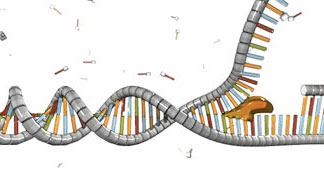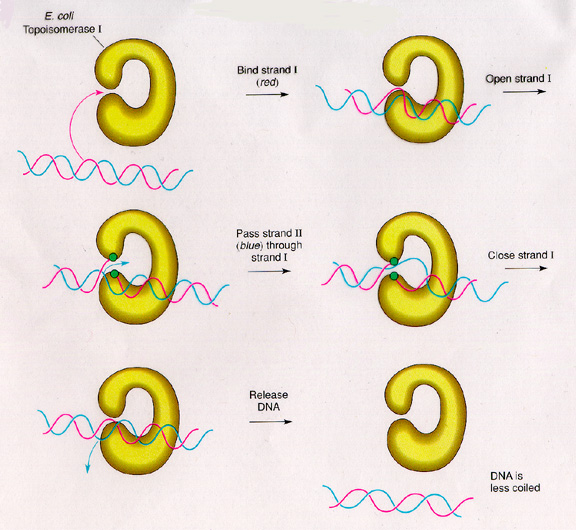DNA REPLICATION-HOW IT WORKS
SIMPLIFIED PROCESS:
- Hydrogen bonds break between two strands, allowing them to unwind and separate
- Each strand then acts as a template for the synthesis of its partner
- When replication is complete, there are two double helices, each with one strand derived from parental DNA molecule base-paired with a newly synthesized one (Semi-conservative replication)
- Semiconservative replication
- One strand is parental DNA and other strand is newly synthesized DNA
- Conservative replication
- One helix is parental DNA and the other helix is newly synthesized DNA
- Dispersive replication
- Helices contain a mixture of both parts of parental DNA and newly synthesized DNA
DNA REPLICATION, HOW THE HECK DOES IT WORK?
I'm going to break down this huge process into smaller bits so it is much easier to understand and grasp. Well let's get started
IT ALL BEGINS WITH HELICASE
In semiconservative replication, two strands of parental DNA unwind and separate to expose template strand for new DNA synthesis. Unwinding of DNA starts at a specific sequence in the chromosome called the ORIGIN OF REPLICATION (ORI). Unwinding at an ori within an DNA molecule actually produces two replication forks: 2 Y's joined together to form a REPLICATION BUBBLE. Movement of the two forks in opposite directions from each origin extends the replication bubbles until the forks eventually meet along the chromosomes to produce fully replicated DNA molecules. ( Note, replication is initiated in the S phase of the eukaryotic cell)
Specific proteins bind to ori and promote the binding of DNA HELICASE, which unwinds the DNA by breaking the hydrogen bonds between each complementary base pair in the direction of 5' to 3'.
Immediately after the DNA is unwound by the helicase, SINGLE STRANDED BINDING PROTEINS (SSBs) coat exposed DNA segments which keeps the DNA strands from recombining.
However, the more the DNA unwinds from ori, the more twisted the DNA becomes. In the cell, to relieve the stress from twisting, an enzyme called TOPOISOMERASE is used to cut one of the parental DNA strands in which it brings it over the other uncut DNA parental strand and rejoins the 2 strand.
HERE COMES DNA POLYMERASE III
Complementary polynucleotides chains are assembled individually from deoxyribonucleotides by enzymes known as DNA POLYMERASE III. Deoxyribonucleoside triphosphates are the substrates (reactants) for the polymeration reaction catalyzed by DNA polymerase III. Nucleoside triphosphate is a nitrogenous base linked to the sugar deoxyribose which is attached to 3 phosphate groups. Since there are 4 different bases in DNA : A, G, T & C - four different triphosphates exist for DNA replication: dATP, dGTP, dCTP, dTTP where d= deoxyribose.
When the parental DNA strand is separated, the 5' end of one strand is opposite to the 3' end of the other. DNA polymerase can only add nucleotides to the 3' end of the existing strand. Oldest end is the 5' phosphate end and the newest end is the 3' OH end. Thus, DNA polymerase III is said to assemble from 5' to 3'.
Because of the antiparallel nature, the template strand is read from 3' to 5' direction.
DNA polymerase III is said to take the shape of a closed human right hand in which the template DNA lies over the palm where the groove is formed between the thumb and fingers. Note, the template strand does not pass through the tunnel formed by thumb and finger domains but rather the template strand and 3' OH of the new strand meet at the active site for the polymeration reaction located in the palm domain. A nucleotide is added to the new strand when an incoming dNTP enters the active site carrying a base complementary to the template strand positioned in the active site.
As the template strand moves, one nucleotide is added one at a time, extending the new DNA strand.
DNA sliding clamp is a protein that encircles the DNA and binds to the rear of the DNA polymerase. FUNCTION: To tether the DNA polymerase, that is to keep the enzyme intact so it wouldn't detach midway.
BEFORE DNA POLYMERASE CAN START, RNA PRIMER NEEDS TO COME IN
In order for DNA polymerase to begin, it needs a existing strand. That is, there needs to be a strand that complementary to the template strand so the DNA polymerase can add the right nucleotides. This is what the RNA PRIMER does. RNA primer contains short chain of few nucleotides which synthesized by the enzyme PRIMASE. Once primase leaves the template, DNA polymerase takes over and extends the RNA primer with DNA nucleotides as it synthesizes the new DNA chain. RNA primers are later removed and replaced with DNA at the end of replication.











No comments:
Post a Comment